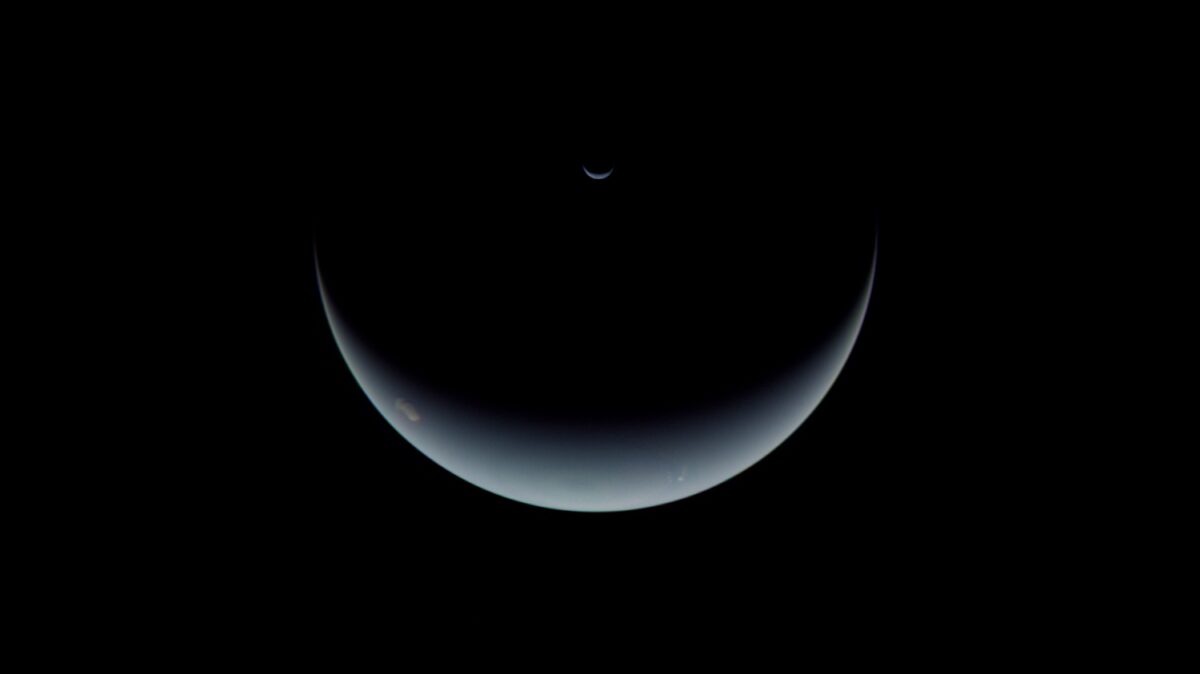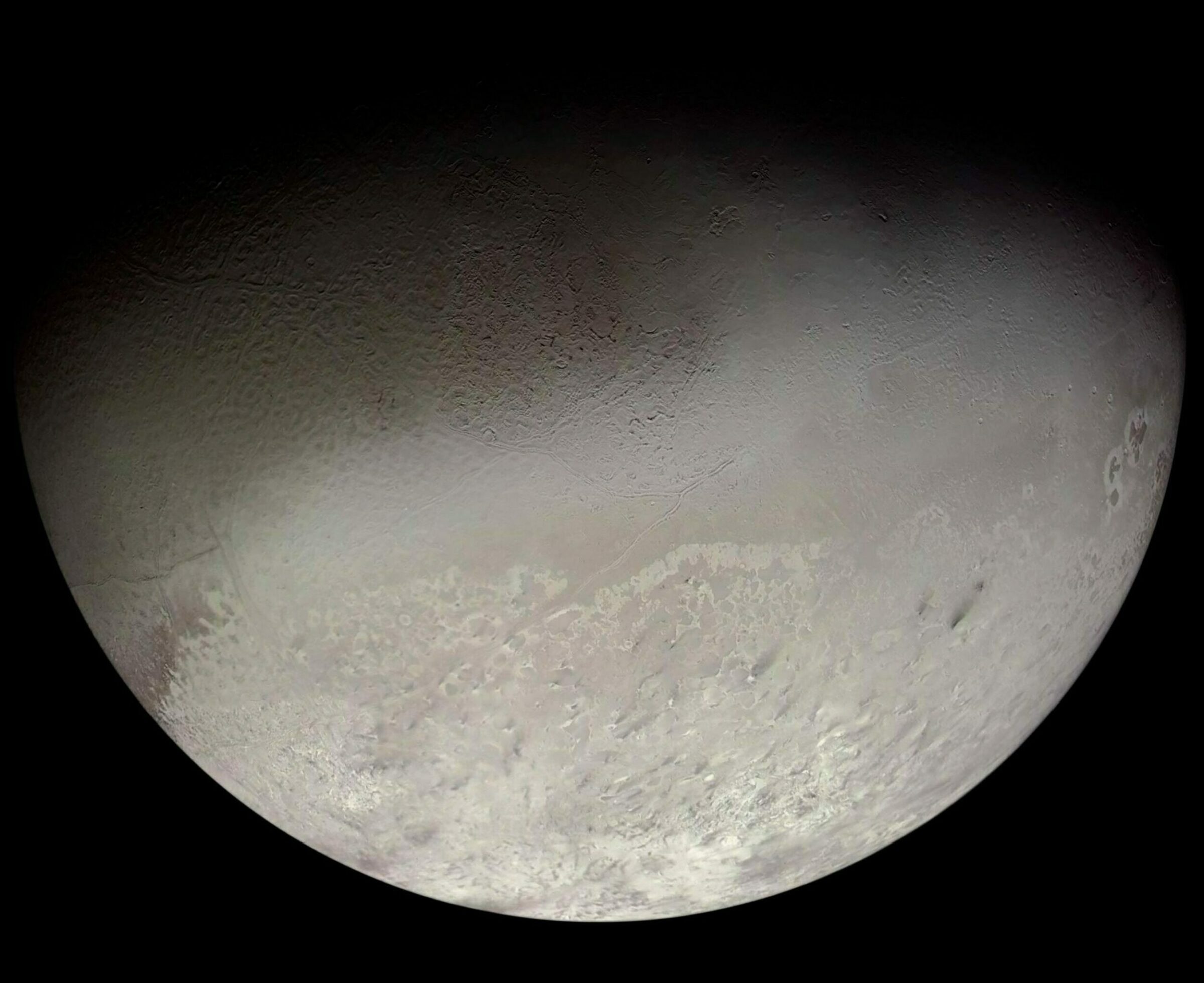Neptune, planet of wind and ice
Highlights
- Neptune is our outermost planet.
- Neptune has been visited by only one spacecraft: Voyager 2.
- The majority of worlds we’ve found around other stars are Neptune-sized. By studying Neptune we learn about other solar systems and whether or not ours is unique.
Why we study Neptune
Neptune, along with its cousin Uranus, is the least-explored planet in our solar system, having been visited by a spacecraft only once. Yet we’ve found more Neptune-sized worlds orbiting other stars than any other type of planet. In order to understand other solar systems and figure out whether our own is unique, we need to learn more about the windy blue world in our own backyard.
Like Jupiter and Saturn, Neptune’s atmosphere consists mostly of hydrogen and helium, but it also has methane that absorbs red light, giving it a deep blue hue. Beneath the atmosphere lies an ocean of water, ammonia, and methane, squeezed by intense pressures into a semi-solid state. For this reason, we call Neptune an ice giant, though the ice isn’t anything like what you’d find in your freezer, with temperatures likely reaching thousands of degrees! Electric currents flowing through this icy-hot ocean may be responsible for powering Neptune’s strong and unusually complex magnetic field.
Where Neptune formed and how it got its water isn’t clear. The disk of dust and gas that formed our solar system probably didn’t contain enough material to form Neptune at its current location, 30 times farther from the Sun than Earth. Like the other outer planets, it was probably born closer to the Sun before moving outward, though the Sun would have evaporated its water had Neptune been too close. By figuring out where Neptune was born and how the planet evolved, scientists learn what conditions in the early solar system were like, around the time life arose on Earth.
Neptune has 14 known moons, half of which were likely captured by the planet’s gravity rather than forming in place. Only one moon, Triton, is big enough to be spherical. It has planet-like characteristics similar to Pluto such as a complex icy surface and thin nitrogen atmosphere and may have started off as a free-roaming dwarf planet. Geysers of nitrogen erupt from Triton’s surface that may be coming from a subsurface water ocean. Future missions would help confirm whether the ocean exists and whether it might be habitable to life as we know it.
Just like Saturn, Neptune has a set of rings shepherded by small moons and made up of cold, icy particles. But its outermost ring is not complete, comprising five distinct arcs. Scientists think the planet’s moon Galatea prevents particles in these arcs from spreading out to complete the ring but no one knows for sure.

Neptune Facts
Average temperature: -201°C (-331°F) where atmospheric pressure equals sea level on Earth
Average distance from Sun: 4,495 million kilometers (2,793 million miles), or 30 times farther from the Sun than Earth
Diameter: 49,528 kilometers (30,775 miles), Neptune is 3.9 times wider than Earth
Volume: 63 trillion km3 (15 trillion mi3), Earth could fit inside Neptune 63 times
Gravity: 11 m/s², or 1.1 times that of Earth’s
Solar day: 16 Earth hours
Solar year: 60,190 Earth days
Atmosphere: 80% hydrogen, 19% helium, 1% other gases
How we study Neptune
It takes a spacecraft a long time to reach Neptune, and we’ve only done it once. NASA launched the nuclear-powered Voyager 2 spacecraft in 1977 to fly past every giant planet in the outer solar system, taking advantage of a rare planetary alignment that only happens every 175 years. Voyager 2 passed Neptune in August 1989.
Its instruments measured an atmospheric temperature of -220 degrees Celsius (-360 degrees Fahrenheit), with wind speeds as high as 2,100 kilometers per hour, possibly driven from heat radiating deep within the planet. Voyager 2 also made the definitive observations of the planet’s rings and saw storms raging across the face of the planet, the largest being an Earth-sized anticyclone similar to Jupiter’s famous Great Red Spot.
Just like at Uranus, Voyager 2 found that Neptune’s magnetic field doesn’t cleanly intersect the planet’s core and is tilted significantly away from the north and south poles. No other planet in our solar system has such complex magnetic fields as the ice giants. Voyager 2 also revealed Triton’s relatively young, crater-free surface, indicating geologic processes at work. Further attesting this were fractures, ridges, and lava plains in the north, as well as nitrogen geysers in the south that hinted at a possible subsurface ocean.
With no new space missions to Neptune since Voyager 2, scientists have relied on the Hubble Space Telescope and large ground-based telescopes to regularly observe the planet. The observations have discovered more moons, monitored seasonal storms, and even detected gases in Triton’s thin atmosphere.
A Neptune orbiter would help us better understand ice giants by measuring the planet’s magnetic field, mapping gravity variations and atmospheric wobbles to understand the core, and observing how heat is radiated on the planet’s night side. A probe dropped into Neptune’s frigid atmosphere could precisely measure the composition of gases, helping scientists figure out where Neptune formed and how it evolved.
China is considering a Voyager-like mission to interstellar space that could make a Neptune flyby and drop off an atmospheric probe. A Triton flyby mission called Trident was proposed to NASA's low-cost Discovery program, but was ultimately passed over in favor of two Venus missions.
The 2023-2032 Planetary Science Decadal Survey — a report produced every 10 years by the U.S. scientific community to guide future NASA missions — recommends sending a spacecraft to Uranus as the highest priority. If commissioned, the Uranus Orbiter and Probe (UOP) mission launching in the 2030s will paint us a clear picture of where and how Uranus formed, and how it subsequently evolved. Because of the two ice giants' similarity, these insights would also likely apply to Neptune. The mission would also provide us with missing information necessary to understand the migration of the gas giants and the connected evolution of our solar system and early Earth.

Action Center
Whether it's advocating, teaching, inspiring, or learning, you can do something for space, right now. Let's get to work.
Acknowledgements: This page was initially written by Jatan Mehta in 2020.


 Explore Worlds
Explore Worlds Find Life
Find Life Defend Earth
Defend Earth


